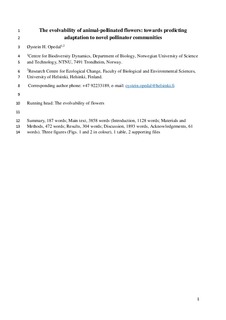| dc.description.abstract | In the event of a community turnover, population decline, or complete disappearance ofpollinators, animal-pollinated plants may respond by adapting to novel pollinators or bychanging their mating system. The ability of populations to adapt is determined by their abilityto respond to novel selection pressures, i.e. their evolvability. In the short term, evolvability isdetermined by standing genetic variation in the trait under selection. To evaluate the evolutionary potential of plant reproductive systems, I compiled genetic-variance estimates for a large selection of floral traits mediating shifts in pollination and mat-ing systems. Then, I computed evolvabilities and compared these among trait groups andagainst the evolvabilities of vegetative traits. Evolvabilities of most floral traits were substantial yet tended to be lower than the medianfor vegetative traits. Among floral traits, herkogamy (anther–stigma distance), floral-displaytraits and perhaps floral-volatile concentrations had greater-than-average evolvabilities, whilethe evolvabilities of pollinator-fit traits were below average. These results suggest that most floral traits have the potential to evolve rapidly in responseto novel selection pressures, providing resilience of plant reproductive systems in the event ofchanging pollinator communities. | nb_NO |
